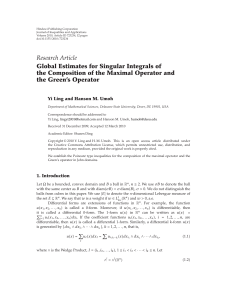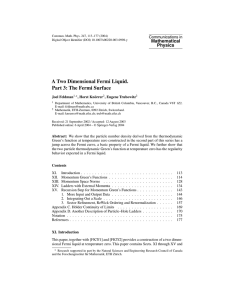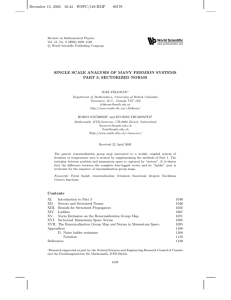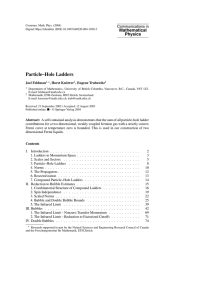Document 10943841
advertisement
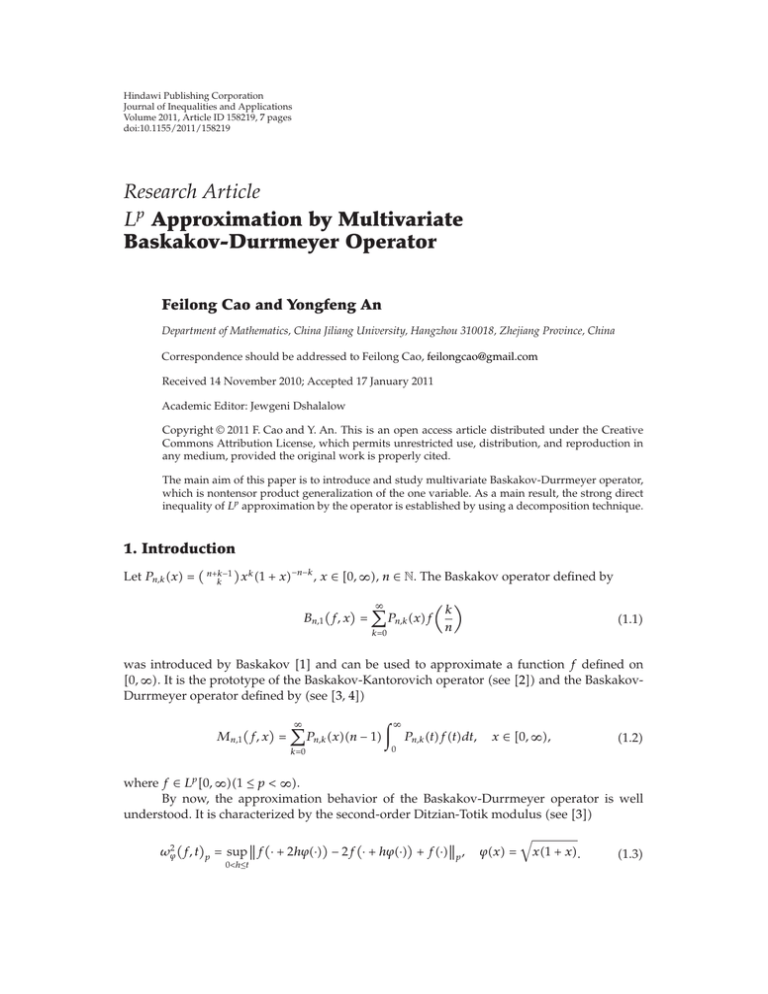
Hindawi Publishing Corporation
Journal of Inequalities and Applications
Volume 2011, Article ID 158219, 7 pages
doi:10.1155/2011/158219
Research Article
Lp Approximation by Multivariate
Baskakov-Durrmeyer Operator
Feilong Cao and Yongfeng An
Department of Mathematics, China Jiliang University, Hangzhou 310018, Zhejiang Province, China
Correspondence should be addressed to Feilong Cao, feilongcao@gmail.com
Received 14 November 2010; Accepted 17 January 2011
Academic Editor: Jewgeni Dshalalow
Copyright q 2011 F. Cao and Y. An. This is an open access article distributed under the Creative
Commons Attribution License, which permits unrestricted use, distribution, and reproduction in
any medium, provided the original work is properly cited.
The main aim of this paper is to introduce and study multivariate Baskakov-Durrmeyer operator,
which is nontensor product generalization of the one variable. As a main result, the strong direct
inequality of Lp approximation by the operator is established by using a decomposition technique.
1. Introduction
Let Pn,k x nk−1 k
xk 1 x−n−k , x ∈ 0, ∞, n ∈ N. The Baskakov operator defined by
Bn,1
∞
k
Pn,k xf
f, x n
k0
1.1
was introduced by Baskakov 1 and can be used to approximate a function f defined on
0, ∞. It is the prototype of the Baskakov-Kantorovich operator see 2 and the BaskakovDurrmeyer operator defined by see 3, 4
∞
Pn,k xn − 1
Mn,1 f, x k0
∞
Pn,k tftdt,
x ∈ 0, ∞,
0
1.2
where f ∈ Lp 0, ∞1 ≤ p < ∞.
By now, the approximation behavior of the Baskakov-Durrmeyer operator is well
understood. It is characterized by the second-order Ditzian-Totik modulus see 3
ωϕ2 f, t p sup f · 2hϕ· − 2f · hϕ· f·p ,
0<h≤t
ϕx x1 x.
1.3
2
Journal of Inequalities and Applications
More precisely, for any function defined on Lp 0, ∞1 ≤ p < ∞, there is a constant such that
1
Mn,1 f − f ≤ const. ωϕ2 f, √1
f p ,
p
n p n
ωϕ2 f, t p O t2α ⇐⇒ Mn,1 f − f p O n−α ,
1.4
1.5
where 0 < α < 1.
Let T ⊂ Rd d ∈ N, which is defined by
T : Td : {x : x1 , x2 , . . . , xd : 0 ≤ xi < ∞, 1 ≤ i ≤ d}.
1.6
Here and in the following, we will use the standard notations
k : k1 , k2 , . . . , kd ∈ Nd0 ,
x : x1 , x2 , . . . , xd ,
xk : x1k1 x2k2 · · · xdkd ,
n
k
k! k1 !k2 ! · · · kd !,
|x| :
d
|k| :
xi ,
i1
:
n!
,
k!n − |k|!
∞
k0
:
∞
∞ d
ki ,
i1
∞
···
k1 0 k2 0
1.7
.
kd 0
By means of the notations, for a function f defined on T the multivariate Baskakov operator
is defined as see 5
∞ k
Pn,k x,
Bn,d f, x :
f
n
k0
1.8
where
Pn,k x n |k| − 1
k
xk 1 |x|−n−|k| .
1.9
Naturally, we can modify the multivariate Baskakov operator as multivariate
Baskakov-Durrmeyer operator
∞
Pn,k xφn,k,d f ,
Mn,d f : Mn,d f, x :
f ∈ Lp T ,
1.10
k0
where
φn,k,d f :
T
Pn,k ufudu
n − 1n − 2 · · · n − d
P
T n,k udu
Pn,k ufudu.
T
1.11
Journal of Inequalities and Applications
3
It is a multivariate generalization of the univariate Baskakov-Durrmeyer operators given in
1.2 and can be considered as a tool to approximate the function in Lp T .
2. Main Result
We will show a direct inequality of Lp approximation by the Baskakov-Durrmeyer operator
given in 1.10. By means of K-functional and modulus of smoothness defined in 5, we will
extend 1.4 to the case of higher dimension by using a decomposition technique.
Fox x ∈ T , we define the weight functions
ϕi x xi 1 |x|,
2.1
1 ≤ i ≤ d.
Let
Dir ∂r
,
∂xir
r ∈ N,
Dk D1k1 D2k2 · · · Ddkd ,
k ∈ Nd0
2.2
denote the differential operators. For 1 ≤ p < ∞, we define the weighted Sobolev space as
follows:
r,p
Wϕ T f ∈ Lp T : Dk f ∈ Lloc Ṫ , ϕri Dir f ∈ Lp T ,
2.3
where |k| ≤ r, k ∈ Nd0 , and Ṫ denotes the interior of T . The Peetre K-functional on Lp T 1 ≤ p < ∞, are defined by
Kϕr
f, t
r
p
d r
r r ϕi Di g p ,
inf f − g p t
t > 0,
2.4
i1
r,p
where the infimum is taken over all g ∈ Wϕ T .
For any vector e in Rd , we write the rth forward difference of a function f in the
direction of e as
⎧ ⎛ ⎞
r
r
⎪
⎪
⎨ ⎝ ⎠−1i fx ihe, x, x rhe ∈ T,
r
Δhe fx i0 i
⎪
⎪
⎩
0,
otherwise.
2.5
We then can define the modulus of smoothness of f ∈ Lp T 1 ≤ p < ∞, as
d Δr ϕi ei f ,
ωϕr f, t p sup
h
p
2.6
0<h≤t i1
where ei denotes the unit vector in Rd , that is, its ith component is 1 and the others are 0.
In 5, the following result has been proved.
4
Journal of Inequalities and Applications
Lemma 2.1. There exists a positive constant, dependent only on p and r, such that for any f ∈ Lp T ,
1≤p<∞
1
ωr f, t p ≤ Kϕr f, tr p ≤ const. ωϕr f, t p .
const. ϕ
2.7
Now we state the main result of this paper.
Theorem 2.2. If f ∈ Lp T , 1 ≤ p < ∞, then there is a positive constant independent of n and f such
that
1
Mn,d f − f ≤ const. ωϕ2 f, √1
2.8
f p .
p
n p n
Proof. Our proof is based on an induction argument for the dimension d. We will also use
a decomposition method of the operator Mn,d f. We report the detailed proof only for two
dimensions. The higher dimensional cases are similar.
Our proof depends on Lemma 2.1 and the following estimates:
⎧ f ,
⎪
⎪
⎨ p
Mn,2 f − f ≤ const.
2 1 p
⎪
2 2 ⎪
ϕD f f p ,
⎩
n i1 i i p
f ∈ Lp T ,
2,p
f ∈ Wϕ T .
2.9
The first estimate is evident as the Mn,d f are positive and linear contractions on
Lp T 1 ≤ p < ∞. We can demonstrate the second estimate by reducing it to the one
dimensional inequality
2 Mn,1 f − f ≤ const. ϕ f f p ,
p
p
n
2.10
which has been proved in 3
Now we give the following decomposition formula:
∞
∞ x2
Pn,k1 x1 Pnk1 ,k2
Mn,2 f, x n − 1n − 2
1 x1
k 0 k 0
1
2
∞
u2
fu1 , u2 du1 du2
1 u1
0
∞
∞
∞
x2
Pn,k1 x1 n − 2
Pn−1,k1 u1 Pnk1 ,k2
1 x1
0
k 0
k 0
×
Pn,k1 u1 Pnk1 ,k2
1
× n k1 − 1
∞
2
Pnk1 ,k2 tfu1 , 1 u1 tdt du1
0
∞
Pn,k1 x1 n − 2
k1 0
∞
0
Pn−1,k1 u1 Mnk1 ,1 gu1 , z du1 ,
2.11
Journal of Inequalities and Applications
5
where
gu1 t fu1 , 1 u1 t,
0 ≤ t < ∞,
z
x2
,
1 x1
2.12
which can be checked directly and will play an important role in the following proof.
From the decomposition formula, it follows that
∞
Pn,k1 x1 n − 2
Mn,2 f, x − fx k1 0
×
∞
Pn−1,k1 u1 Mnk1 ,1
gu1 , z − gu1 z du1
0
∗
Mn,1
h·, x1 − hx1 : J L,
2.13
where
x2
hu1 : hu1 , x : f u1 , 1 u1 , 0 ≤ u1 < ∞,
1 x1
∞
∞
∗
Pn,l y n − 2
Pn−1,l tgtdt.
Mn,1 g, y 2.14
0
l0
Then by the Jensen’s inequality, we have
p
Jp ≤
≤
∞
∞
p
Pn,k1 x1 n − 2
Pn−1,k1 u1 Mnk1 ,1 gu1 , z − gu1 zdu1 dx
T k1 0
0
∞
∞
Pn,k1 x1 n − 2
0
T k1 0
∞ ∞
p
Pn−1,k1 u1 Mnk1 ,1 gu1 , z − gu1 z du1 dx
Pn,k1 x1 1 x1 dx1 n − 2
∞
0 k1 0
Pn−1,k1 u1 0
p
× Mnk1 ,1 gu1 , z − gu1 z dzdu1
∞
∞
n k1 − 1 ∞
Mnk ,1 gu , z − gu z p dzdu1
≤
Pn−1,k1 u1 1
1
1
n−1
0
0
k 0
2.15
1
≤ const.
∞
n k1 − 1 ∞
k1 0
n−1
0
1
Pn−1,k1 u1 n k1
p p
2 p ϕ gu1 gu1 p du1 .
p
However, by definition, one also has
ϕ2 tgu1 t t1 t1 u1 2 D22 fu1 , 1 u1 t ϕ22 D22 f u1 , 1 u1 t.
2.16
6
Journal of Inequalities and Applications
Therefore,
p
Jp ≤ const.
∞
n k1 − 1
−
1n k1 p
n
k1 0
∞
Pn−1,k1 u1 0
p p × ϕ22 D22 f u1 , 1 u1 t fu1 , 1 u1 t dt du1
const.
∞
n k1 − 1
−
1n k1 p
n
k1 0
∞
1
Pn−1,k1 u1 1 u1
0
∞ p p 2
×
ϕ2 u1 , u2 D22 fu1 , u2 fu1 , u2 du1 du2
0
∞
const. ≤
np k 0
1
∞
0
2.17
∞ p p 2
Pn,k1 u1 ϕ2 u1 , u2 D22 fu1 , u2 fu1 , u2 du1 du2
0
p
const. 2 2 p ϕ2 D2 f f p .
p
np
To estimate the second term L, we use a similar method as to estimate 2.10 see 3
and can get
Lp ≤
Denoting ϕ12 x ϕ21 x :
have
const. 2 ϕ h hp .
p
n
√
2.18
2
2
x1 x2 , D12
: ∂2 /∂x1 ∂x2 , and D21
: ∂2 /∂x2 ∂x1 , we
2
ϕ sh s
x22
x2
x2
x2
2
2
2
2
s1 s D1 f D f
D f
D22 f × s, 1 s
1 x1 12
1 x1 21
1 x1 1 x1 2
1 x1
x2
x2
s
2 2
2
2
2
2
2 2
.
ϕ D f ϕ12 D12 f ϕ21 D21 f ϕD f
s, 1 s
1 x1 x2 1 1
1 s 1 x1 x2 2 2
1 x1 2.19
Recalling that ϕ12 x is no bigger than ϕ1 x or ϕ2 x, and the fact
2
D12 fx ≤ sup D12 fx, D22 fx
2.20
proved in 6 see 6, Lemma 2.1, we obtain
2 2 ϕ h ≤ const. ϕ2i Di2 f ,
p
i1
p
2.21
Journal of Inequalities and Applications
7
and hence
const.
Lp ≤
n
2 2 2 ϕi Di f f p .
i1
p
2.22
The second inequality of 2.9 has thus been established, and the proof of Theorem 2.2 is
finished.
Acknowledgment
The research was supported by the National Natural Science Foundation of China no.
90818020.
References
1 V. A. Baskakov, “An instance of a sequence of linear positive operators in the space of continuous
functions,” Doklady Akademii Nauk SSSR, vol. 113, pp. 249–251, 1957.
2 Z. Ditzian and V. Totik, Moduli of Smoothness, vol. 9 of Springer Series in Computational Mathematics,
Springer, New York, NY, USA, 1987.
3 M. Heilmann, “Direct and converse results for operators of Baskakov-Durrmeyer type,” Approximation
Theory and its Applications, vol. 5, no. 1, pp. 105–127, 1989.
4 A. Sahai and G. Prasad, “On simultaneous approximation by modified Lupas operators,” Journal of
Approximation Theory, vol. 45, no. 2, pp. 122–128, 1985.
5 F. Cao, C. Ding, and Z. Xu, “On multivariate Baskakov operator,” Journal of Mathematical Analysis and
Applications, vol. 307, no. 1, pp. 274–291, 2005.
6 W. Chen and Z. Ditzian, “Mixed and directional derivatives,” Proceedings of the American Mathematical
Society, vol. 108, no. 1, pp. 177–185, 1990.


